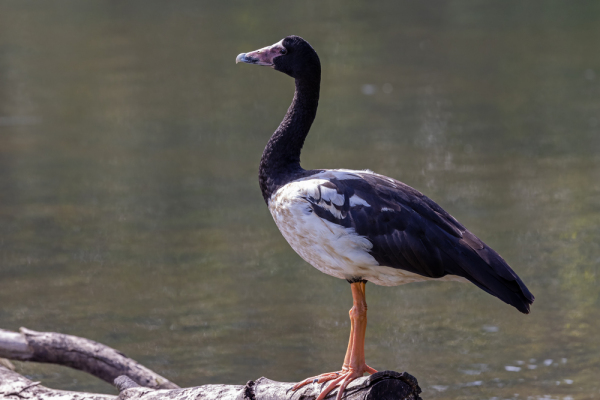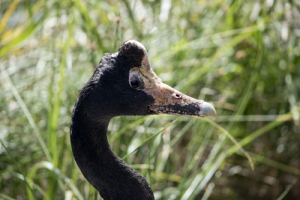
The Magpie Goose(Anseranas semipalmata) is a goose-like bird that is placed in its own family Anseranatidae. Unlike true geese Magpie Geese have partially webbed feet. The Magpie Goose lives in Australia.

Physical Characteristics
The Magpie Goose has a black neck and head. The wings are mostly black as well. The legs and feet are orange. Magpie Geese have partially webbed feet. There is a Protuberance on the heads of Magpie Geese that is variable in size, but smaller in females. The face is naked and red. Juveniles are grayer and more mottled.
| Length | 70-90 cm(2’3.6”-2’11.4”) |
| Wingspan | 1.2-1.8 m(3’11.2-5’10.9”) |
| Weight. | 1.4-3.2 kg(3.1-7.1 lbs.) |
*Subspecies
The Magpie Goose is currently classified as a monotypic species, this means that there are no subspecies classified under Anseranas semipalmata. Subspecies are populations that show subtle differences from other populations.
Range
The Magpie Goose can be found in Australia, and New Guinea.
Habitat
Magpie Geese inhabit swamps, and floodplains.
Breeding
Usually one male mates with two females, all of which incubate the eggs and feed the young. The nest is a large floating mound of vegetation, with a deep unlined cup. The clutch consists of 5–14 pale cream to yellowish-white eggs; The eggs weigh 76-138 gm. The incubation period is 23 to 35 days. A chick is covered with gray down, but is whiter below, with a cinnamon head and neck. Magpie Geese reach sexual maturity between 2 to 4 years.
Diet
Magpie Geese eat blades of grass, seeds, bulbs, rhizomes, and tubers
Predators
Birds of prey, the Dingo(Canis lupus dingo), and snakes prey on the eggs and chicks of the Magpie Goose.
Conservation Status
The Magpie Goose is listed as least concern.
Fun Facts
- The Magpie Goose is the only Goose in the world that can sleep in trees. They have a strong hind toe that gives them a firm grip on branches.
- The largest known Magpie Goose colony covered almost 47 square kilometers(18 square miles).
- Magpie Geese can live for up to 26 years.
- A Magpie Goose hatchling can weigh up to 104 gm(3.67 oz).
